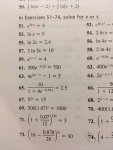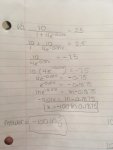mysticaurora1
New member
- Joined
- Nov 15, 2017
- Messages
- 1
The question with which I'm requesting assistance in is question 65. It is from the chapter titled "Exponential and Logarithmic Functions" and requires us to solve for X:
\(\displaystyle \textbf{65. }\, \dfrac{10}{1\, +\, 4\ e^{-0.01x}}\, =\, 2.5\)
((10/ (1+ 4e^-0.01x) )) = 2.5
Here is my work:
. . . . .\(\displaystyle \dfrac{10}{1\, +\, 4\ e^{-0.01x}}\, =\, 2.5\)
. . . . .\(\displaystyle \dfrac{10}{1}\, +\, \dfrac{10}{4\ e^{-0.01x}}\, =\, 2.5\)
. . . . .\(\displaystyle \dfrac{10}{4\ e^{-0.01x}}\, =\, -7.5\)
. . . . .\(\displaystyle (10)\ (4\ e^{-0.01x})\, =\, -7.5\)
. . . . .\(\displaystyle 4\ e^{-0.01x}\, =\, -0.75\)
. . . . .\(\displaystyle e^{-0.01x}\, =\, -0.1875\)
. . . . .\(\displaystyle \ln\left(e^{-0.01x}\right)\, =\, \ln(-0.1875)\)
. . . . .\(\displaystyle -0.01x\, =\, \ln(-0.1875)\)
. . . . .\(\displaystyle x\, =\, -100\, \ln(-0.1875)\)
I have attached a picture of my work. However; the answer in the textbook states the correct answer is
. . . . .x = -100 ln 3/4
so I don't understand where I've gone wrong. Please guide me towards where I went wrong in my process.
Thanks in advance!
\(\displaystyle \textbf{65. }\, \dfrac{10}{1\, +\, 4\ e^{-0.01x}}\, =\, 2.5\)
((10/ (1+ 4e^-0.01x) )) = 2.5
Here is my work:
. . . . .\(\displaystyle \dfrac{10}{1\, +\, 4\ e^{-0.01x}}\, =\, 2.5\)
. . . . .\(\displaystyle \dfrac{10}{1}\, +\, \dfrac{10}{4\ e^{-0.01x}}\, =\, 2.5\)
. . . . .\(\displaystyle \dfrac{10}{4\ e^{-0.01x}}\, =\, -7.5\)
. . . . .\(\displaystyle (10)\ (4\ e^{-0.01x})\, =\, -7.5\)
. . . . .\(\displaystyle 4\ e^{-0.01x}\, =\, -0.75\)
. . . . .\(\displaystyle e^{-0.01x}\, =\, -0.1875\)
. . . . .\(\displaystyle \ln\left(e^{-0.01x}\right)\, =\, \ln(-0.1875)\)
. . . . .\(\displaystyle -0.01x\, =\, \ln(-0.1875)\)
. . . . .\(\displaystyle x\, =\, -100\, \ln(-0.1875)\)
I have attached a picture of my work. However; the answer in the textbook states the correct answer is
. . . . .x = -100 ln 3/4
so I don't understand where I've gone wrong. Please guide me towards where I went wrong in my process.
Thanks in advance!
Attachments
Last edited by a moderator:


